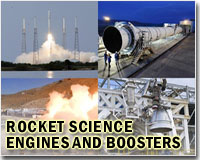 |
Washington (AFP) Aug 31, 2010 NASA and aerospace company ATK Aerospace Systems successfully tested Tuesday the most powerful solid-fuel rocket engine ever, even though its future in the space program remains in doubt. A huge roar and massive flames accompanied the two-minute "static" or non-flight test of the five-segment DM-2 (Demonstration Motor 2) rocket booster in the western desert state of Utah. The DM-2 was designed as the first stage of the Ares I rocket to provide the lift-off thrust for the next generation of Orion spacecraft, which NASA hoped would return astronauts to the moon by 2020. US President Barack Obama has said he plans to cancel the Constellation program in which the boosters would have been used, throwing the fate of the next-generation engine into question. The second test of the DM-2 was aimed at seeing if it could work at lower temperatures and verify the performance of new design materials. The solid rocket boosters are an upgrade in design over ones used to propel NASA's shuttle fleet into space and are the largest and most powerful ever designed for flight. Once the shuttle program ends early next year, the United States will rely on Russia's Soyuz rockets to carry its astronauts to the International Space Station until a commercial US launcher can be developed, scheduled for 2015. The second test of the DM-2, aided by more than 760 on-board measurement devices, showed the motor's performance had met all expectations. "For every few degrees the temperature rises, solid propellant burns slightly faster," said Alex Priskos, first stage manager for Ares Projects at NASA's Marshall Space Flight Center in Huntsville, Alabama. "Only through robust ground testing can we understand how material and motor performance is impacted by different operating conditions." Seeking to cut the massive US budget deficit, Obama's administration has proposed scrapping the costly and over budget Constellation rocket program. Instead, NASA would concentrate on research and development that could, over a longer time-frame, eventually see astronauts travel outside low Earth orbit and even aim for Mars. The US space agency would also be encouraged to develop operations with commercial partners to fly astronauts to the space station.
Share This Article With Planet Earth
Related Links Rocket Science News at Space-Travel.Com
 Launch of privately-built Danish rocket delayed: builder
Launch of privately-built Danish rocket delayed: builderCopenhagen (AFP) Aug 30, 2010 The launch into space of Denmark's first privately-built rocket has been postponed to Thursday due to bad weather conditions, one of its builders said. "The wind delayed the transportation of the rocket from Copenhagen to (the island of) Bornholm. But we hope to take our prototype on Tuesday to the launch base in order to be able to take off on Thursday," said Peter Madsen. Madsen, 39, a ... read more |
|
| The content herein, unless otherwise known to be public domain, are Copyright 1995-2010 - SpaceDaily. AFP and UPI Wire Stories are copyright Agence France-Presse and United Press International. ESA Portal Reports are copyright European Space Agency. All NASA sourced material is public domain. Additional copyrights may apply in whole or part to other bona fide parties. Advertising does not imply endorsement,agreement or approval of any opinions, statements or information provided by SpaceDaily on any Web page published or hosted by SpaceDaily. Privacy Statement |